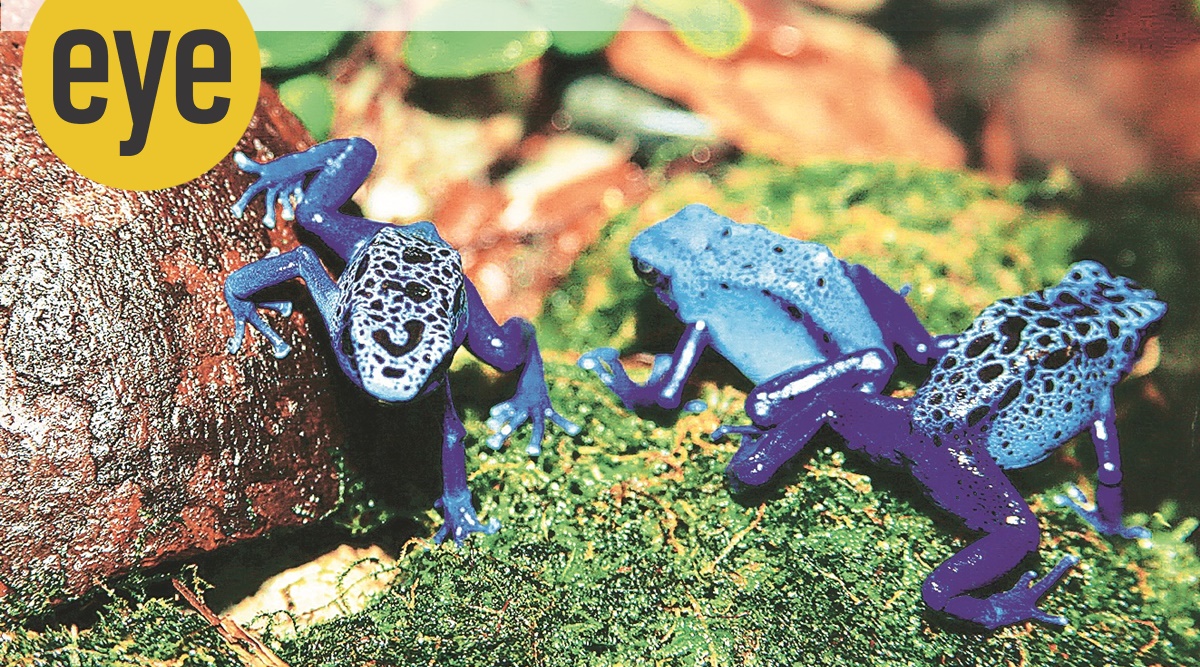 Tiny Tormentors :Poison dart frogs (Photo: Ranjit Lal)
Tiny Tormentors :Poison dart frogs (Photo: Ranjit Lal) Right from our childhood, we are told big animals are dangerous. At the top of the most-feared list are the carnivores — lions, tigers, leopards, hyenas and bears on land, and crocodiles and sharks in the water. The growls and snarls of the big carnivores are warning enough, not to mention their fearsome four-inch canines with which they’ll crunch your bones and muscles. The submarine attackers rear up in a heart-stopping moment of sheer violence or slink up from beneath to chomp you clean in half.
Generations have been brought up on such horror stories as well as stirring tales of brave hunters setting forth to rid us of these scourges. People in villages and small towns around which these man-eating predators hunted, lived in thrall of fear, locking themselves indoors at dusk — though, sometimes, even this was not enough. And then, with an unerring shot, the hunter took down the menace and celebrations were in order and the beast was paraded through the village to assure everyone that it was indeed dead. These days, with our new love for lynching, often the entire male population of the village will hysterically hunt down the predator and beat it to a pulp. We’ve hunted down more than 90 per cent of tigers, so the chances of you meeting one and becoming lunch while on a walk in the jungle are minuscule.
Old jungle hands might tell you that more than the carnivores, the big vegans need to be feared. In most Indian forests, wild elephants are considered to be the most dangerous: silent as smoke, intelligent and merciless. Worse, gangs will not hesitate to invade villages and lay waste — snarfing up food grain, sugarcane and vegetables — and guzzling down the homemade moonshine at the local bar. Other notorious vegans include rhinos and wild buffalo, who are famously short-tempered and likely to charge on sight. Out in Africa, the hippo is considered the most dangerous, killing more people than the big cats. Even the portly wild boar can prove to be an unpredictable foe, ready to lacerate you with its tusks. It’s telling that these guys don’t even eat you, just mash you into the dirt and leave with a triumphant toss of their heads.
Then there is the almost universally-hated (and -feared) kingdom of reptiles. All snakes as well as lizards — from the giant Komodo dragon to the smiling wall gecko — are considered to be venomous. Besides, we have seen what crocodiles and alligators can do. The psychedelic arrow-poison frogs of Central and South America can take down 20 men by mere touch, and so, the native Indians tipped their hunting arrows with the poison. In the seas and oceans, strange monstrous-looking fish and beautiful mollusks are loaded with venom. Touch them and you’ll writhe in agony. Get stung by the lacy jellyfish trailing yards of silken strands and you are nearly done for.
Above water, birds are taught to be feared, too. Eagles carry babies and small children away; owls pluck your eyes out or cast spells on you and crows mob you mercilessly if you take potshots at them. Then, there is the mind-boggling diversity of insects and arachnids: experienced jungle hands are more afraid of these than of big game. The smaller the creatures get the deadlier they become. Mosquitoes, rat fleas, flies en masse create havoc among us. Spiders have accounted for more of us than all the big carnivores put together. But we can still see and hear them — and zap, if necessary, or simply swat.
There’s a multitude of life forms — mortal enemies, many of them — which we can neither see nor hear nor smell, but just feel the terrible effects of, once they attack us. Microbes, bacteria and viruses — the smallest and most diverse — are the most dangerous.
Seen through microscopes, they’re no less frightening than a snarling tiger, as they ruthlessly get to work invading and destroying our cells and devastating our health. We may have developed weapons of mass destruction against many of them, but they develop immunities as fast as we up the ante. Many are evilly ingenious: the terrible rabies virus knows it has doomed its host and so leaves the party as soon as it can — by deliberately causing its host to go berserk and bite someone, so it can be transferred through saliva to a new host — and continue the good work there. Others take over the brains of their hosts to ensure they get the best facilities for the propagation of their species.
Since small size matters more, if you really want to be deadly, be small, invisible, odourless and silent and come up trumps.